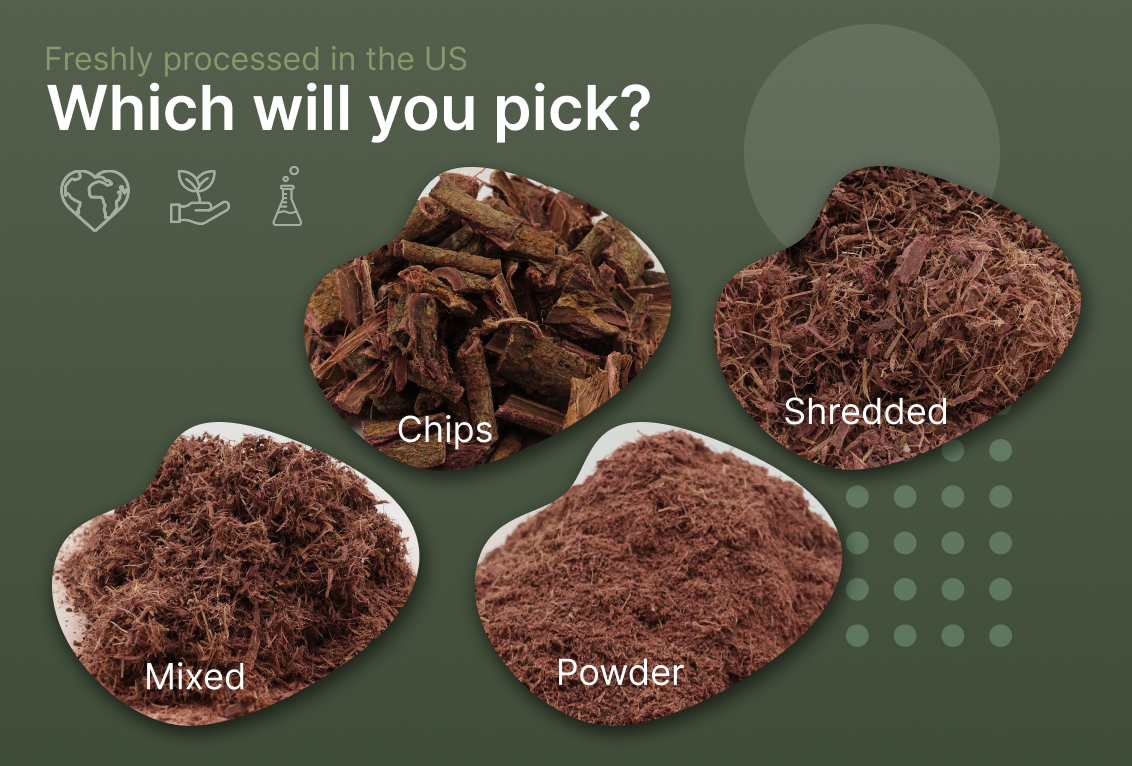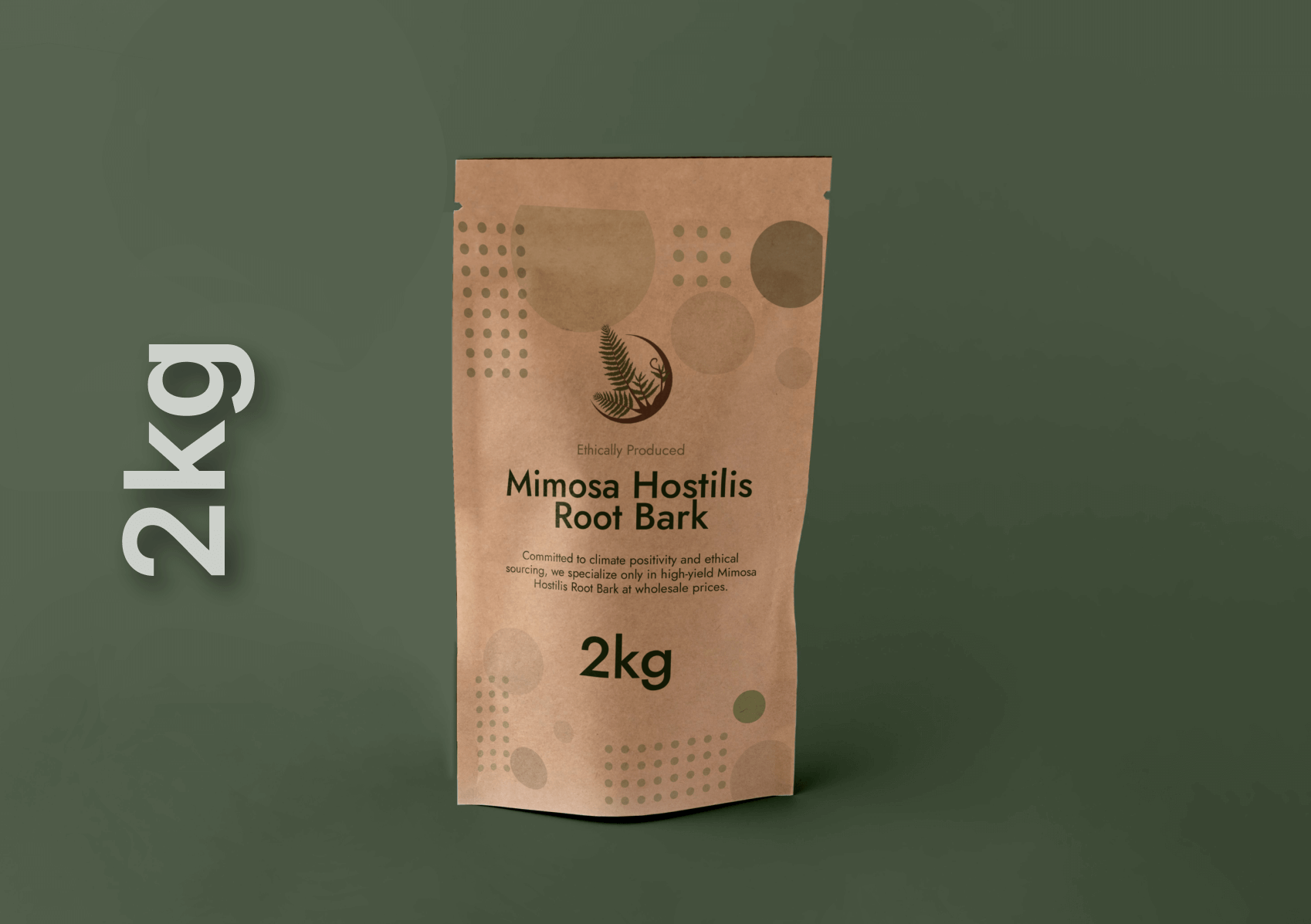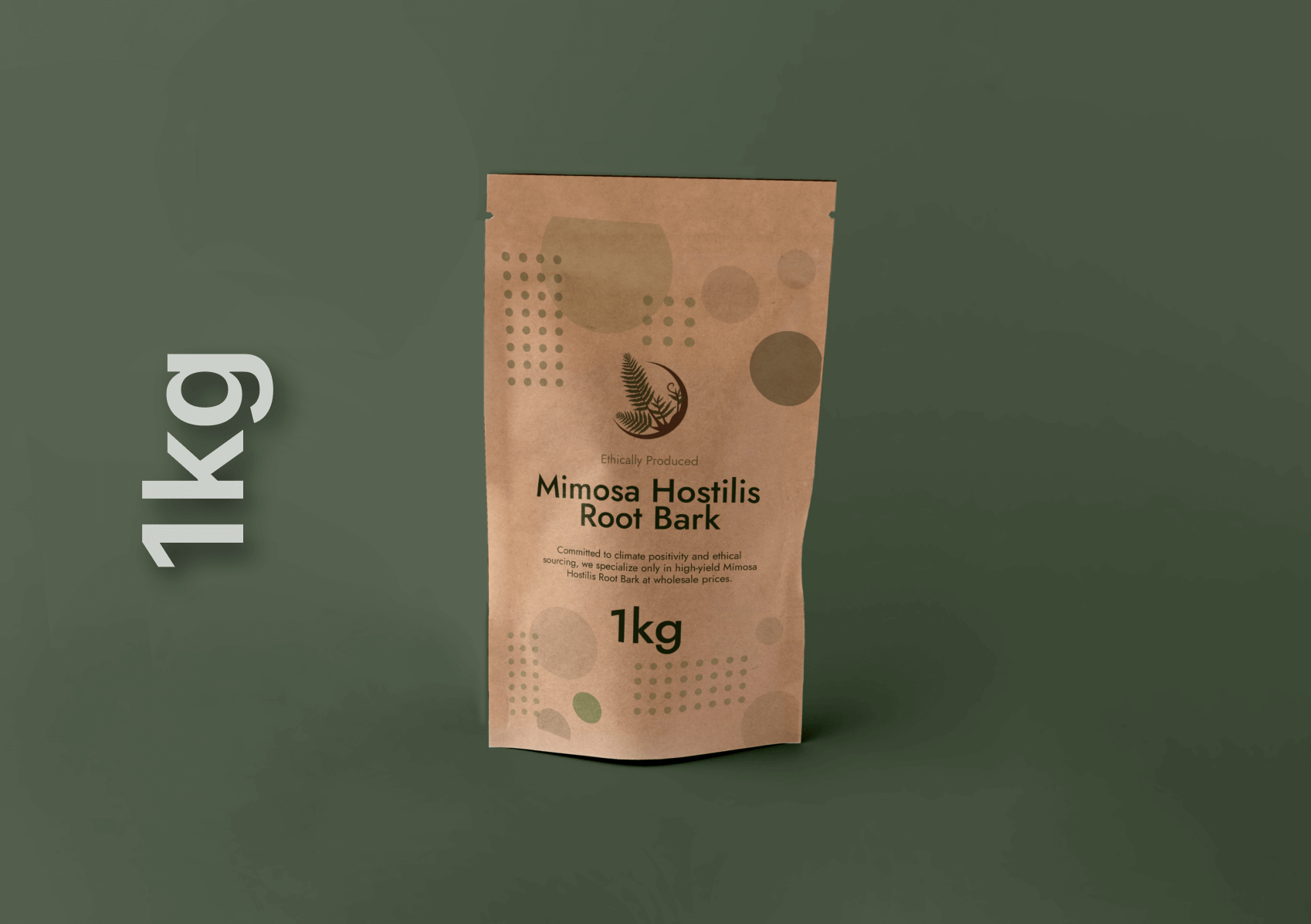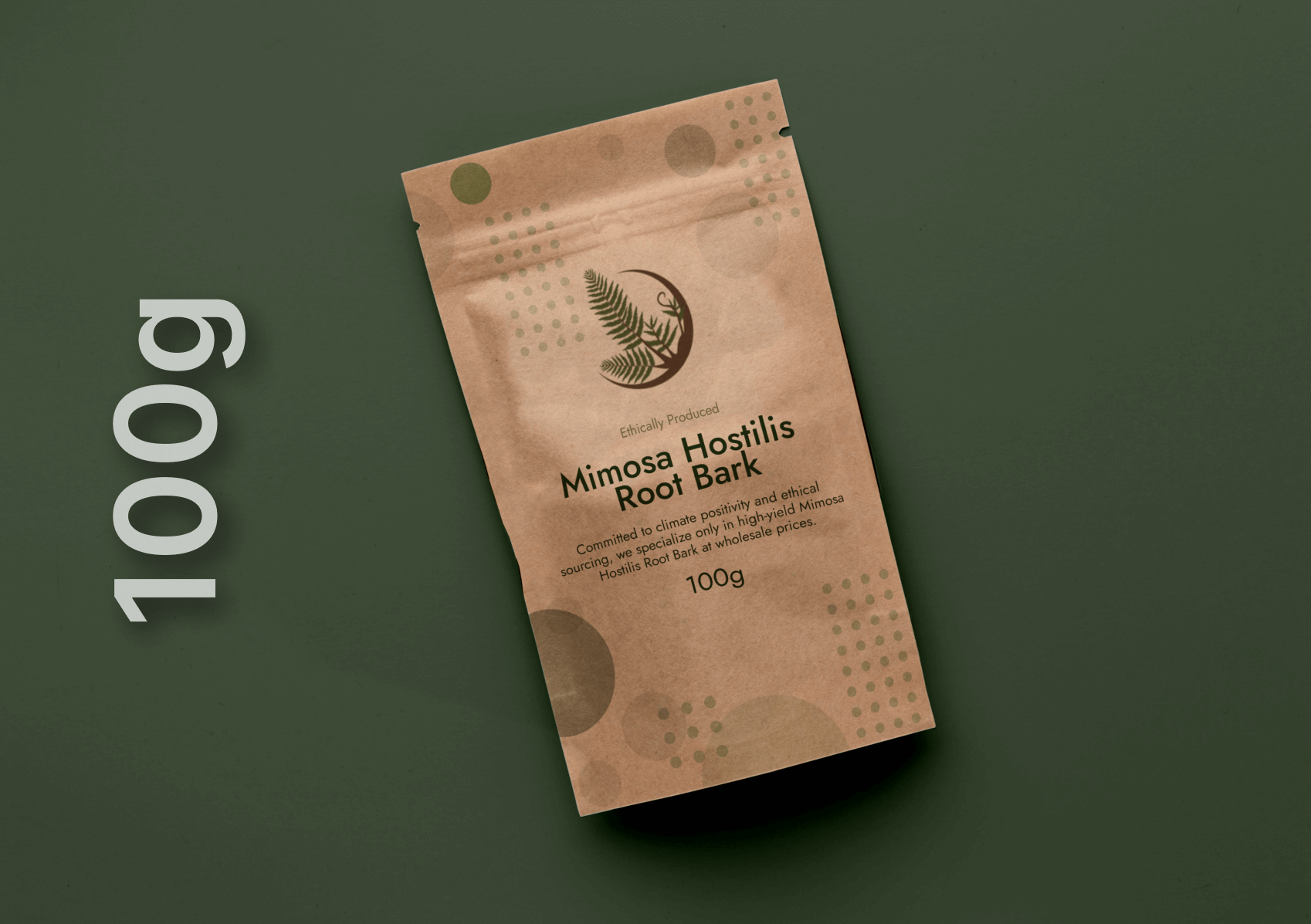Mimosa Hostilis (syn. Mimosa tenuiflora) root bark is gaining attention as a natural dye alternative for industrial applications. Traditionally known in South America as “tepezcohuite,” this high-tannin bark produces deep reddish-purple dyes and has been used for centuries in textile dyeing and leather tanning. In the modern U.S. context, corporations and artisans are exploring Mimosa Hostilis Root Bark (MHRB) for sustainable industrial dyeing of textiles, leather, and even cosmetics. This comprehensive analysis examines the economics of using MHRB versus other dye sources, focusing on cost, scalability, sustainability, market demand, and U.S. regulations.
Background: Mimosa Hostilis as a Natural Dye Source
MHRB is derived from a hardy tree native to Brazil, Mexico, and Central America. It contains a high tannin content (≈16%), which makes it a strong natural dye and a vegetable tanning agent. Indigenous Brazilian cultures have long used MHRB to dye textiles and tan leather. When boiled, the root bark yields pigments ranging from reddish-brown to purple, depending on the mordants (e.g. alum, iron) used. Unlike typical synthetic dyes, MHRB is organic and biodegradable; for example, it can dye cotton, wool, silk, and leather with minimal chemical additives.
Commercially, U.S. suppliers offer MHRB as shredded bark or fine powder. One U.S.-based retailer lists “Mimosa Hostilis Root Bark – Shredded (1kg)” at $180 per kilogram. These price points are considerably higher than many synthetic dyes (which often cost only a few dollars per kg) and even above some other specialty natural dyes (see comparison table below). MHRB is marketed for its vibrant color output and eco-friendly profile, but its economics differ sharply from conventional dyes.
Industrial Dyeing: Natural vs. Synthetic
Historically, synthetic dyes have dominated the textile industry. They are “cheaper, brighter, and more reliable” than natural dyes. In fact, over 90% of all commercial dyes used globally are synthetic. Synthetic dye production is an industrial chemical process, enabling mass-scale output at low per-unit cost (often on the order of a few dollars per kg in bulk. However, synthetics pose environmental problems: they require high volumes of water and often contain toxic precursors, leading to pollution unless heavily treated.
By contrast, natural dye alternatives (plant- or insect-derived) have seen renewed interest amid sustainability trends. Market analysts report the global natural dye market was about $5.07 billion in 2024, projected to grow to $8.95 billion by 2034 (CAGR ~5.9%). Major drivers include consumer demand for eco-friendly products and stricter regulations on synthetic chemicals. For instance, industries like textiles, leather, and cosmetics are increasingly adopting natural dyes for their biodegradability and non-toxicity.
In the U.S. specifically, brands in fashion and home textiles are marketing natural-dyed fabrics as premium, sustainable goods. However, natural dyes typically require higher usage rates (more dye per fabric weight) and more complex processing (e.g., multiple dye baths or mordants). These factors lead to higher costs. A specialty article notes that “natural dyes contain less colorant per weight and often need stronger mordants,” making them more expensive to use. MHRB, rich in tannins, can sometimes serve as its own mordant (due to its astringency), but still generally requires significant quantities for industrial application.
Cost Comparison: Mimosa Hostilis vs. Other Dyes
A key economic factor is raw material cost. The table below compares typical costs, scalability, sustainability, and regulatory factors for MHRB and representative competing dyes:
| Dye Source | Cost (USD/kg) | Scalability | Sustainability/Impact | Regulatory Notes |
|---|---|---|---|---|
| Mimosa Hostilis Root Bark | ~$100–180 (domestic, high grade) | Limited: Grown mainly in Brazil/Mexico; wild harvest risks; small-scale farming | Natural and biodegradable, but overharvesting can threaten trees; requires sustainable sourcing | Bark contains DMT (Schedule I). Imports often seized; domestic cultivation less regulated but not widespread. |
| Natural Indigo (plant) | ~$115–185 (natural extract) | Moderate: can be farmed (e.g., in India, Japan); supply is seasonal | Renewable crop; historical use; environmental footprint lower, but yields variable | Non-controlled, widely recognized; GOTS-certified organic versions exist. |
| Cochineal (insect) | ~$320 (1kg) | Low: requires raising insects on cactus; labor-intensive; limited scale | Renewable but involves live insect farming; very concentrated dye; biodegradable | Approved food/cosmetic colorant (FDA); no major legal issues for trade. |
| Other Tannin Dyes (e.g. Walnut) | ~$40–100 (e.g. walnut hulls ~$40/kg) | Moderate: byproduct of walnut farming; relatively common supply | Sustainable if sourced from waste; natural wastewater biodegradable | Generally unregulated; considered safe natural extract. |
| Synthetic Reactive Dyes (e.g. Reds, Blues) | ~$1–10 (bulk price) | High: Mass-produced in chemical plants; easily scaled. | Efficient production, but generate toxic effluents; non-biodegradable components | Subject to EPA wastewater rules; no trade restrictions; cheap raw material inputs. |
This comparison highlights that MHRB is much more expensive per kg than synthetic dyes (which can be <$10/kg in bulk and often more costly than other specialty natural dyes. For example, a top indigo supplier charges ~$185/kg for organic indigo, and high-grade cochineal goes for ~$320/kg. MHRB’s price (roughly $100–180/kg) is competitive only with other exotic natural extracts, not with commodity dyes. Moreover, MHRB supplies are limited to specific regions, whereas synthetic dyes have a global, mass-market supply chain.
In terms of cost per dyed fabric, initial estimates suggest that using MHRB is substantially more costly. A rudimentary calculation: if a typical synthetic reactive dye might require ~5 grams per kg of fabric (at ~$5/kg dye) yielding ~$0.025 material cost per kg fabric, MHRB (at 1–5% usage rate) could cost on the order of $0.50–$5 per kg of fabric. Such a price premium constrains MHRB to high-end or niche markets unless costs drop.
Scalability and Supply Chain
The scalability of a dye source depends on how easily it can be cultivated, harvested, and delivered. Synthetic dyes win hands-down here: they are made in automated plants from petrochemicals or coal-tar derivatives, and manufacturers can quickly ramp up or shift production based on demand. Natural dyes, by contrast, depend on agricultural and wild resources.
MHRB is primarily harvested from wild trees in Brazil’s caatinga region and to some extent cultivated on small farms in Mexico and Peru. Annual production volumes are unknown but likely limited to a few hundred tons at most. By comparison, indigo plants and cochineal insects are farmed, and millions of hectares worldwide grow dye crops (or feed crops to dye insects). Walnut hulls, an example of a tannin source, are plentiful as an agricultural byproduct.
Scaling up MHRB would require expanding plantations or managed forests for Mimosa tenuiflora. However, this is challenging because the species naturally grows in specific climates (semi-arid tropics). Establishing new supply chains could take years or decades, and without strong regulatory incentives or subsidies, large agribusinesses may hesitate to invest.
Even if supply could be secured, import logistics add complexity. Given MHRB’s regulatory issues (discussed below), U.S. companies often prefer domestic suppliers or stocks cleared by customs. For example, one U.S. vendor advertises fast, discreet shipping from U.S. warehousing to avoid customs delays. In contrast, a kilogram of synthetic dye or common natural indigo faces no such hurdles and can be imported or produced cheaply.
Sustainability and Environmental Impact
A major appeal of natural dyes like MHRB is sustainability. MHRB is organic and renewable (trees regrow, unlike petroleum). Its dyes and tannins are non-toxic and biodegradable, so effluent from dye baths is far less hazardous than from synthetic processes. For instance, using MHRB for leather tanning means substituting vegetable tanning for chromium salts; vegetable tanning is safer for workers and creates no heavy-metal sludge. Indeed, industry reports note “vegetable tanning…can be more expensive than…chrome tanning,” but results in a more eco-friendly.
However, sustainability depends on responsible harvesting. If demand spikes, MHRB could be overharvested, threatening wild stocks. Ethical suppliers emphasize sustainable practices: reforestation, harvesting from managed groves, and fair-trade partnerships. One article cautions buyers to “source Mimosa Hostilis from suppliers who practice sustainable methods,” highlighting wild-harvest certification and reforestation programs.
Synthetic dyes, while cheap, carry a significant environmental toll. Textile dye production is extremely water-intensive (hundreds of tons of water per ton of dye and generates toxic effluent (heavy metals, azo compounds, etc.). Regulations in the U.S. (EPA effluent limits, wastewater treatment) increase operational costs for large dye users. In contrast, dyeing with MHRB or other plant dyes can often utilize simpler treatment: organic residues can be composted rather than chemically neutralized.
To summarize sustainability:
-
MHRB: Renewable, biodegradable, generally low toxicity. Risk of deforestation if unregulated. Natural tannins can sometimes act as both dye and mordant, reducing chemical inputs.
-
Other natural dyes (indigo, cochineal, walnut, etc.): Generally sustainable when farmed responsibly. Fewer pollutants than synthetics.
-
Synthetic dyes: Cheap and scalable but generate significant pollution and have high energy/water footprints.
Market Demand and Industry Trends
The U.S. market for natural dyes is still niche but growing. Key drivers include eco-conscious consumers and sustainable fashion trends. According to market research, the natural dyes sector (covering fashion, cosmetics, and specialty food) is expanding at a healthy pace. U.S. textile companies and designers are increasingly highlighting “plant-dyed” clothing lines. Similarly, some cosmetic brands tout “tepezcohuite” (MHRB) extract in skincare products for its regenerative properties (a practice popularized in Latin America).
However, the volume of MHRB actually used industrially remains small. Most MHRB in the U.S. is currently sold in small lots to craftspeople, natural product enthusiasts, or boutique manufacturers. For example, a community of artisans and small leather tanners may use MHRB or similar tannin-rich barks for handcrafted goods. Large-scale mills have largely not switched to MHRB en masse due to cost and supply issues.
That said, some companies do use natural dyes at scale. Indigo (natural and synthetic), madder, and some plant extracts have established supply chains. MHRB might find a foothold particularly in leather goods (handmade saddlery, artisan shoes, wallets) and boutique textile production. There is even interest in using MHRB colorants in cosmetics or soaps (often as a marketing angle for a “natural, traditional” ingredient).
Importantly, one of the trends fueling natural dyes is regulation: state laws or guidelines sometimes penalize toxic dyes. While the U.S. federal government has not banned any major synthetic textile dyes outright, the public and private pressure on companies to reduce hazardous chemicals is intensifying. Some brands have voluntarily eliminated certain AZO or heavy-metal-containing dyes, opening niche demand for any natural alternative. Natural dyes like MHRB can be marketed as part of a safer, greener process in corporate sustainability reports.
U.S.-Specific Regulatory and Import Considerations
A critical factor for MHRB economics in the U.S. is legality and import control. While Mimosa Hostilis itself is not explicitly a controlled plant species, its root bark contains dimethyltryptamine (DMT), a Schedule I drug. U.S. Customs and Border Protection (CBP) has repeatedly seized shipments of Mimosa bark under drug laws. In one 2022 case, CBP intercepted a parcel marked “Mimosa Tenuiflora” and found 57 pounds of bark testing positive for DMT. The release explicitly noted DMT’s Schedule I status and lack of medical use.
These enforcement actions mean importing MHRB carries risk. Many U.S. vendors therefore emphasize domestic stock or discreet shipping to avoid seizure. Some advice (from industry forums) is to import whole, unground bark (as fibers) rather than powder, to reduce detection, but there is no guaranteed “safe” method. The reality is that under 21 U.S. Code § 952, any importation of Schedule I substances (including plants containing them) is illegal without an exemption.
For companies contemplating MHRB, this means either sourcing from U.S. distributors (who have legally imported it), or facing a legal compliance process (which could involve DEA registration or FDA color-additive petitions if used in products). In short, regulatory hurdles make MHRB costlier: delays, testing, and potential losses must be factored into the supply chain.
By comparison, no such issues arise with most synthetic dyes or approved natural colorants (like cochineal) in terms of import legality. Synthetic dyes follow standard chemical import regulations (customs, tariffs, possibly EPA reporting), and cochineal is classified as a food/color additive (registered and widely traded).
One more regulatory angle: color additives. In the U.S., any dye used in food, drugs, or cosmetics must be FDA-approved. While textiles and leather dyes are outside FDA’s purview, if MHRB were used in a skincare product, its pigment would need to comply with FDA’s color additive rules. Currently, there is no FDA-approved listing for tepezcohuite dye specifically. Brands using MHRB in cosmetics often navigate this by marketing it as an herbal extract (which is a gray area). Thus, companies must be careful: if MHRB-pigmented fabric is sold with an “all-natural” claim, they should ensure it is not mis-marketed as a colorant in cosmetics without approval.
Key U.S. regulatory considerations (in summary):
-
Import Control: MHRB shipments are subject to customs inspection for DMT; illegal imports can be seized.
-
Drug Laws: No FDA/DEA exceptions for MHRB in food/drugs/cosmetics unless petitioned (unlikely for a dye).
-
EPA/OSHA: Use of MHRB in factories still triggers standard workplace and environmental regulations for any organic dust or effluent (though lower hazard than heavy chemicals).
Industrial Applications of MHRB
Despite challenges, MHRB has viable niches in industrial dyeing:
-
Textiles: MHRB can dye natural fibers (cotton, wool, silk) to warm brown-purple tones. It acts as an acid dye on protein fibers and a substantive dye on cellulose. Unlike many plant dyes, it binds relatively well without excess synthetic mordants. Artisanal tie-dye and batik projects often cite MHRB for its “rich color output”. In an industrial context, it could serve small-batch or specialty fabric lines. Some cloth mills could integrate MHRB dye vats with existing equipment, but they must adjust for its longer extraction times (boiling bark for hours.
-
Leather Tanning and Dyeing: MHRB’s high tannin content (16%) means it is excellent for vegetable tanning. Tanneries could use MHRB instead of traditional tannin sources (e.g. quebracho, chestnut) to produce naturally tanned leather. The resulting leather has a warm “rustic tone” and is chromium-free, which appeals to eco-leather markets. In leather dyeing, MHRB can also deepen color or add an antiquing effect. A leather manufacturer might use MHRB powders in their dye baths to both tan and color hides in one step. However, as noted, vegetable tanning is slower and costlier than chrome tanning, so MHRB-tanned leather will fetch higher prices or target environmentally-conscious buyers.
-
Cosmetics and Personal Care: While not a mainstream industrial dye, MHRB extracts (often called tepezcohuite) are used in skin care products for purported healing and anti-aging benefits (ironically due to tannins and antioxidants). In the U.S., any coloring effect in these products must comply with FDA rules. So far, MHRB pigments are mostly a marketing point (“with natural botanical extract”) rather than a certified color additive.
-
Other Uses (Paper, Wood Stain): Some creators use MHRB in papermaking for an earthy tint, and woodworkers apply MHRB dye for staining wood. These are niche craft applications rather than large-scale industry, but they reflect MHRB’s versatility.
Business Use Cases:
-
A textile startup might incorporate MHRB as a differentiator in a luxury eco-label, accepting higher material costs to appeal to conscientious consumers.
-
A leather goods company focused on sustainability could market “vegetable-tanned with Mimosa tannins” as a premium feature.
-
A cosmetics firm could highlight tepezcohuite’s heritage in skincare, though they would mostly use it for its natural branding rather than as a primary colorant.
Comparative Summary and Outlook
Overall, the economic viability of Mimosa Hostilis in U.S. industrial dyeing depends on the specific application. If price and regulatory hurdles can be managed, MHRB offers unique sustainable advantages that synthetic dyes lack. Its role will likely remain in high-end, niche markets (organic textiles, eco-leather, artisanal crafts).
Pros of MHRB:
-
Natural and renewable dye source, with strong tannins enabling both dyeing and tanning.
-
Eco-friendly process: low-toxicity effluent, potential for sustainable supply if managed correctly.
-
Market cachet: appeals to sustainability and heritage narratives in branding.
Cons of MHRB:
-
High raw material cost ($100–200/kg vs. <$10/kg for synthetic.
-
Limited supply and scalability, making large-volume use difficult.
-
Regulatory/legal risk: containing DMT means import/transport scrutiny.
-
Higher processing: often requires higher dye doses and more labor (boiling, long soak times) than industrial chemical dyes.
A cross-industry comparison underscores that synthetic dyes remain dominant due to cost and performance, while natural dyes (including MHRB) fill specialized roles. The market trend toward sustainability provides niche growth potential: the natural dyes market is projected to grow ~6% annually. Within that market, MHRB competes with other high-end botanicals (like organic indigo or rare barks).
Example Comparison Table
Here is a concise comparison of MHRB and key competitors:
| Attribute | Mimosa Hostilis Bark | Synthetic Reactive Dyes | Natural Indigo (plant) | Cochineal (insect) |
|---|---|---|---|---|
| Color Range | Reddish-purple to brown (with mordants) | Very broad (all colors) | Deep blue (only natural blue dye) | Bright red to purple (depends on pH) |
| Typical Cost | ~$100–180 per kg | ~$1–10 per kg | ~$115–185 per kg | ~$320 per kg |
| Batch Size (kg order) | Tens to hundreds (small farms/wholesale) | Tons (large chemical plants) | Tens to hundreds (cultivated fields) | Tens (specialized insect farms) |
| Scalability | Limited (tropical growth, manual harvest) | Extremely high (industrial) | Medium (agricultural expansion possible) | Low (labor and habitat constraints) |
| Sustainability | Renewable, biodegradable, natural tannins; risk of overharvest | Non-renewable inputs; toxic effluent | Renewable crop; historical use (less toxic effluent) | Renewable (insects), sustainable if managed |
| Regulatory Issues | Contains DMT: Import illegal without license | No major import restrictions; EPA discharge regulated | No special restrictions | FDA-approved for food/cosmetics; widely used |
| Applications | Textiles (brown-purple), leather (vegetable tannin), cosmetics | Textiles (cotton, silk), leather, plastics, etc. | Textile dye (blue jeans, etc.) | Food coloring, textiles, cosmetics (red shades) |
In the table, notice MHRB’s niche strengths (renewability, tannin content for tanning and weaknesses (cost, legality).
Conclusion
Mimosa Hostilis Root Bark presents an intriguing natural dye option for industrial use, especially where sustainability and natural branding are valued. However, its economics — high material cost, limited supply, and U.S. regulatory complications — mean it cannot easily replace cheaper synthetic dyes in mainstream production. Instead, MHRB is best suited to specialty applications: eco-conscious textile lines, vegetable-tanned leather goods, and artisanal crafts.
In the U.S. market, these niche uses may justify the premium for MHRB. For instance, a high-end furniture maker might pay extra for MHRB-dyed leather if it aligns with their green certification, while a mass garment factory will likely stick with standard reactive dyes. Importantly, the growth of the natural dyes market suggests expanding opportunities: by 2034, global demand for botanical dyes is forecast to rise ~80%. If that trend continues, innovative solutions to scale and legalize MHRB (e.g., domestic cultivation or DEA permits) could improve its economics.
Until then, businesses considering Mimosa Hostilis must weigh cost against brand value and environmental benefit. In summary, MHRB’s economic viability is context-dependent: it is not a drop-in replacement for cheap synthetic colorants, but a premium raw material for specialized industrial dyeing processes that prioritize sustainability and natural origins.




